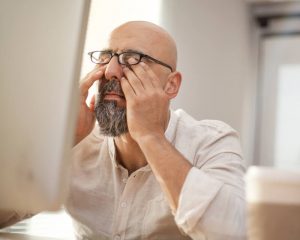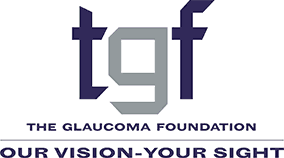
Dry eye disease is a common eye disorder in which the eyes don’t make enough tears, or the tears evaporate too quickly. It can make your eyes feel dry, scratchy, and irritated or watery, and it can cause vision fluctuation and a heavy, tired feeling of the eyes.
Many glaucoma patients have signs and symptoms of dry eye. In fact, studies suggest that from 50 to 60 percent of people who are being treated for glaucoma also have dry eye syndrome.
One reason for this correlation is that the occurrence of both glaucoma and dry eye increases with age. Another factor is glaucoma patients’ long-term use of pressure-lowering eye drops, many of which contain the preservative benzalkonium chloride (BAK). BAK is known to damage cells on the ocular surface, resulting in dry eye signs and symptoms. Dry eye is further aggravated by time spent in front of computers and video screens and in air-conditioned environments.
Normally, tears are produced by several glands. The lacrimal glands produce the watery tears through openings in the upper eyelids. Meibomian glands in both the upper and lower eyelids just behind the eyelashes produce the oily smooth outer layer of tears that stops the watery tears from evaporating.
Because most dry eye disease patients have eyes that don’t make enough tears, and they also lose their tears too quickly, treatment often addresses both issues.
There are different treatment options your eye doctor may suggest, depending on the type and severity of your condition. Among them:
Artificial tears are eye drops used as a replacement for watery tears. Gels and ointments are also available. They usually last longer in the eye and need to be put in less frequently, but can blur the vision. There are many different types of artificial tears available without prescription.
Punctal plugs are sometimes used in dry eye treatment to help tears remain on the surface of the eye longer.
To express natural oily tears to the eye surface, at-home hygiene techniques such as eyelid cleansing and daily warm eyelid compresses can help to minimize clogged glands and inflammation of the eyelids. In-office procedures may also be suggested. One procedure, LipiFlow, also known as thermal pulsation, is aimed specifically at meibomian gland dysfunction-related evaporative dry eye.
Your doctor may suggest switching to preservative-free glaucoma eye drops.
Addressing lifestyle factors can also help manage dry eye associated with glaucoma. Some studies have found that supplements and foods containing omega-3 fatty acids can decrease dry eye symptoms. And remember to take frequent breaks during computer use and to blink often when you are reading or viewing a computer screen.
Like glaucoma, dry eye disease is chronic. But today, ophthalmologists have a growing number of effective treatments to manage the condition and improve quality of life.
